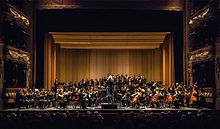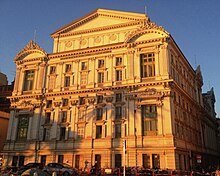Orchester Philharmonique de Nice

The Orchester Philharmonique de Nice (Nice Philharmonic) is the orchestra of the city of Nice and is considered one of the leading opera and symphony orchestras in France. It was officially founded in 1945 as "L'Orchestre Symphonique Municipal de la Ville de Nice" (Symphony Orchestra of the City of Nice).
In 1982 the orchestra was renamed “Orchester Philharmonique de Nice”. In the following 15 years it had up to 120 musicians who, in addition to several tours, including the Théâtre des Champs-Élysées in April 1988, caused jubilation with their remarkable interpretation of Richard Wagner's " Ring des Nibelungen " under Berislav Klobučar .
From 2010 to 2016, Philippe Auguin was chief conductor and musical director of the Orchester Philharmonique de Nice. György G. Ráth has been his successor since 2017.
Music directors
- Georges Lauweryns (1945–1946)
- Charles Boissard (1946–1948)
- Marcel Dorssers (1948–1950)
- Richard Blareau (1956-1959)
- Jean Périsson (1959-1965)
- Paul-Maria Jamin (1965–1976)
- Antonio de Almeida (1976–1978)
- Pierre Dervaux (1978–1981)
- Berislav Klobučar (1981-1989)
- Spiros Argiris (1989–1990)
- Klaus Weise (1990–1997)
- Marcello Panni (1997-2001)
- Marco Guidarini (2001-2009)
- Philippe Auguin (2010-2016)
- György G. Ráth (since 2017)
Venues
The orchestra's home is in the Opéra de Nice . Rehearsals are also held in La Diacosmie , a 20,000 m², five-story building with a rehearsal stage, set workshop, rehearsal rooms for ballet, choir, singers and orchestra. The orchestra rehearsal room (Studio Louis Fourestier ) is 410 m² and offers space for 200 musicians.
The Orchester Philharmonique de Nice also plays concerts and operas in the auditorium of the Acropolis, a 2,500-seat modern concert hall.
activities
Guest Conductor
Guest conductors of this orchestra were among others Georges Prêtre , Wolfgang Sawallisch , Marek Janowski , Berislav Klobučar , Emil Tchakarov , Zoltán Peskó , Jerzy Semkow , Michael Schønwandt , Leopold Hager , Günter Neuhold , Jascha Horenstein , David Zinman and Emmanuel Krivine .
Guest soloists
- Violin: Julian Rachlin , Vadim Repin , Frank Peter Zimmermann , Vladimir Spivakov , Augustin Dumay , Renaud Capuçon , Shlomo Mintz , Salvatore Accardo , Olivier Charlier , Guy Braunstein .
- Flute: Emmanuel Pahud .
- Trumpet: Sergei Nakariakov .
- Horn: Radovan Vlatković , Bruno Schneider , Stefan Dohr .
- Viola: Yuri Bashmet .
- Cello: Antonio Meneses , Truls Mørk , Natalia Gutman , János Starker , Pieter Wispelwey , Mischa Maisky , Sonia Wieder-Atherton .
- Clarinet: Paul Meyer , Sabine Meyer .
- Oboe: Albrecht Mayer .
- Piano: Viktoria Postnikova , Alexandre Tharaud , Ivo Pogorelich , Mikhail Rudy , Bruno Leonardo Gelber , Aldo Ciccolini , Nicholas Angelich , François-René Duchâble , Roger Muraro , Krystian Zimerman , Nelson Freire , Mikhail Rudy, Jean-Yves Thibaudet , Boris Beresowski , ...
- Singing: Edita Gruberová , Plácido Domingo , Jonas Kaufmann , Rolando Villazón , Waltraud Meier , José van Dam , Françoise Pollet , Kurt Rydl , Véronique Gens , Inva Mula , Leonie Rysanek , Nathalie Stutzmann .
Trivia
The Orchester Philharmonique de Nice must have existed before it was officially founded in 1945, as there is much evidence and records of a flourishing operatic and cultural life in Nice before and around the turn of the century.
For example, Verdi's La forza del destino (1873), Wagner's Lohengrin (1881) and Das Rheingold (1902) and Tchaikovsky's Eugene Onegin (1895) were performed for the first time in France in Nice . The operas La vida breve (The Short Life) by Manuel de Falla on April 1, 1913, The Conquest of Troy by Hector Berlioz (1890) and the staged version by Marie-Madeleine von Massenet (February 9, 1903) premiered in Nice.
On Wednesday, March 23, 1881, during a performance of Donizetti's Lucia di Lammermoor, a fire broke out in the Opéra de Nice (then still Théâtre Municipal) due to a gas explosion on the stage ramp, in which around 200 people died. After four years of construction, the reopening took place on February 7, 1885 with Verdi's opera Aida , in which the orchestra played in the orchestra pit.
This representative cross-section of opera productions from before 1945 is a clear reference to a long operatic tradition of this great orchestra.
Discography
In the course of its existence, the orchestra has released many recordings. The following recordings are an excerpt.
- All of Mozart's piano concertos with Klaus Weise .
- Songs by Richard Strauss , Richard Wagner and Alban Berg with Françoise Pollet and Klaus Weise .
- Les Ponts de Paris by Joseph Kosma with François Le Roux and Vincent Monteil.
- A recital by Marcelo Álvarez conducted by Mark Elder for Sony Classical.
- Herodias by Jules Massenet with Georges Prêtre and Grace Bumbry .
- Several recordings under the direction of Michael Schønwandt , including Pelléas et Mélisande (music by Jean Sibelius , Gabriel Fauré and Arnold Schönberg ).
- The first complete recording of Richard Strauss' orchestral songs under the direction of Friedrich Haider , with Adrianne Pieczonka , Edita Gruberová , Judith Howarth, Petja Petrova, Peter Straka, Kurt Moll and Bo Skhovus.
literature
- Ernest Hildesheimer: Le Philharmonique de Nice. In: Jean-Paul Baréty: Nice Historique. Un Siécle de Musique á Nice. Nice 1994, OCLC 475735648 , pp. 108-113. ( nicehistorique.org )
- Robert Rourret: Nice et L'opéra. R. Rourret, Grasse 2012, ISBN 978-2-9527645-1-3 .
Web links
- Orchester Philharmonique de Nice (French)
- Opéra de Nice (French)
- Association Française des Orchester ( Memento of May 9, 2014 in the Internet Archive ) (French)
- Philippe Auguin
Individual evidence
- ^ Ernest Hildesheimer: Le Philharmonique de Nice. Pp. 108-113.
- ^ Biography de l'Orchestre Philharmonique de Nice. In: Center National de Création Musicale (CIRM). July 24, 2019 (French).
- ^ György Ráth nouveau Directeur musical de l'Orchestre Philarmonique. In: Nice Premium. March 3, 2017 (French).
- ↑ Opéra - Un peu d'histoire. on archive.wikiwix.com.
